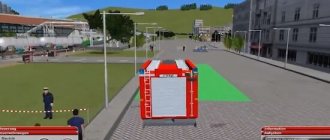: Reading time:
Today, all parents are concerned about the early development of their child, almost from the cradle they take him to developmental studios, numerous clubs and sections. A child is taught letters as soon as he begins to walk, or even earlier. The desire to raise a child to be a genius leads to the devaluation of a simple game. She seems like a waste of time to parents. Is it really? What are the benefits of games for children? Psychologist Victoria Melikhova tells.
Before the baby can even stand on his feet, his mother takes him to the development studio. Experienced teachers offer a wide variety of classes to develop motor skills, memory, attention, thinking, speech, and emotional intelligence. Methods have been invented to teach letters and numbers to a one-year-old baby! Dancing, sports, swimming pool, gymnastics, speed reading, special kindergartens with a slope, mental arithmetic for preschoolers... And then preparation for school appeared on the horizon.
“I try to give my child everything. It is still small, which means it absorbs like a sponge. I don’t want to miss the moment, because later it will be much more difficult for him to learn and develop than now,” says the mother of a wonderful baby. “Besides, running from circle to circle, I myself feel significant and valuable to him, because I do everything that depends on me.”
We will not talk about the benefits or harms of early development and such upbringing (of course, parents are guided by good goals), but we will draw attention to the fact that in such a “race for development” the child does not have time to just play.
Parents don't understand why children should play
In my practice, I have often encountered the fact that parents often underestimate children's play. I have to explain to parents why children need to play.
“Just leave him unattended, so he will immediately start playing around.”
We begin to figure out what it means to “play around”: taking toys out of the closet, throwing construction sets around, running around the room with a typewriter, scattering beans with a spoon... Wait a minute! It seems that what we are talking about here is that the child is playing. He examines toys and studies surrounding objects. Curiosity is one of the most important qualities for a baby! He is trying to “cook soup”, pretending to be a taxi driver. Only for mom all these actions are united by the word “indulge.” A separate problem is if this happens in public places.
“She is constantly mischievous. Either he will bring stones and place them in the middle of the room, or he will pour sand on the table. As soon as I turn away, something will inevitably be pulled over my head. I just don’t have the strength.”
Yes, often children during games (especially mobile and active ones) can cause some inconvenience, ruin the established order, turn over toys and even stain the carpet. But are these losses comparable to what a child receives during simple games... So why do children need games?
What children's games teach
It's not just about entertainment. Let us remember that at every age a person has a leading type of activity. This is an activity during which growth, learning, personality formation, and the development of all skills, knowledge and abilities occur. And for a child, such an activity is precisely play.
What does the game give to children of different ages?
The youngest children tend to manipulate objects. They study the material world. They can look at objects, perform incomprehensible actions with them, taste them, smell them. They are interested in how the stone falls, so they will throw it many times and watch it fall. They are fascinated by the process of pouring sand. Grain of sand to grain of sand. He falls, hits the table and bounces again. Well, why not magic!
The most important thing is that all these actions are performed by the child himself. He can influence objects and move them. It is he who creates the sound of falling stones and running water. Oh, how great he feels at this time, how he wants to share his achievements with you! And how many interesting things there are around!
In addition to the physical meaning of throwing objects, which consists in studying its properties, the sound when falling, the ability to influence the environment, there is also a psychological meaning.
Oh, how great he feels at this time, how he wants to share his achievements with you! And how many interesting things there are around!
The child scatters pencils - the mother collects them and returns them. Pencils are coming back. They go away for a while, walk, but then return home. The mother accepts the child and the abandoned pencils and returns them. If something goes away, it will come back. The mother who left the room will return, the baby who went for a walk will return. After departure comes return, there is a cycle. This is how one becomes aware of the basic patterns, what children’s games teach, among other things.
At the level of objective play, the child is still of little interest in peers and communication. All their attention is focused on themselves, surrounding objects, their physical properties and studying their ability to influence these objects.
Gradually, the child begins not only to throw objects and try them out, but also to study their generally accepted properties and pay attention to their functions. You can eat with a spoon, the car rolls, and you can build a tower out of cubes. And finally, around the age of three, plots appear in a child’s games.
The kid comes up with fantastic stories and builds new worlds. He becomes a warrior or a cook, a mother or father, a teacher or a doctor. The child tries out various social roles, tries them on himself, he rehearses for adult life.
You can live thousands of lives in a day, experience a wide variety of images, and experience the most unpredictable situations.
The child tries out various social roles, tries them on himself, he rehearses for adult life.
Games contribute to the development of a child’s imagination, fantasy, and creative potential. The baby learns to experience a variety of feelings. Today he is an angry wolf, and tomorrow he is a cowardly hare or a brave lion. He learns, helps himself to understand what it’s like to be angry, to be afraid, to fight.
In the game, the child learns to communicate, looks for his place in society, in life. It’s like he’s rehearsing life itself! And for this he was given his entire childhood.
The role of play in the development of preschool children
How games affect the development of preschoolers
Teacher of MBDOU DS No. 20 “Little Red Riding Hood”
Pitonina N.V.
Play is a special activity that blossoms in childhood and accompanies a person throughout life. In theory, play is considered from various perspectives. The game is a way of exploring the world, because... a playing child creates his own world; the game has an impact on the overall mental development of the child; the game helps to assimilate social experience. While the child is still young, all games are addressed individually to him. He is amused and entertained with simple games with sounding, noisy colorful toys, and joke games. Here are “Ladushki” and “Magpie-Crow”. But then the child learned to walk and the nature of the games changed dramatically. The game is a kind of preparation for future work: both physical development and the cultivation of intelligence, ingenuity, and initiative. The strength and sincerity of experiences during play contributes to the formation of the child’s psyche. No matter how simple the game of “Mothers and Daughters”, “Dolls”, “Train” is, it reflects the desire to embody your observations of the life around you, your experiences. Children are very observant and at four years old they want to know everything. Games contain an element of struggle, cause competition among children, which means joy, caution, and this captivates children. The most popular folk games are built according to this plan: “A Bear in the Forest”, “Cat and Mouse”, “Geese and Swans”. The most common games are role-playing games, such as “Shop”, “Rescuers”, “Hospital”, “Beauty Salon”.
The plot-role-playing game is creative in nature, where children take on roles and reproduce the activities and relationships of adults. In such games, children are capable of interesting inventions; they themselves add variety to this or that game. Children's initiative has a huge impact on the education of not only one child, but also the entire group.
An interesting game increases the child’s mental activity, and he can solve a more difficult problem than in class. Didactic games are especially interesting for children because of their entertainment and content: guess, find, name. Children achieve results in the game, guided by certain rules. Interest in the quality of the game task is manifested: carefully folding a pattern, choosing the right picture, and so on. In games with rules, generalization of knowledge and independent choice in solving the problem are required.
Thanks to the game, the child receives comprehensive development and forms social and everyday experience for later life. A game is a kind of school in which a child actively and creatively learns the rules and norms of people’s behavior, their attitude to work, public property, and their relationships. It is a form of activity in which the social behavior of children themselves, their attitude to life, to each other, and personal values is largely formed.
The relationship between play and learning does not remain unchanged throughout preschool childhood. In younger groups, play is the main form of learning. In senior education, especially in preparatory education, the role of the learning process itself in the classroom increases significantly. Children are interested in more complex games that require intellectual activity. They are also attracted to sports games that contain an element of competition.
Play is important both for preparing a child for the future and for making his present life full and happy. To accomplish this task, it is necessary to create in kindergartens all the conditions for a variety of games, treat them carefully, respectfully, thoughtfully, and skillfully manage them.
Children really need to play together with adults. Children love to play travel games, play out the plots of their favorite fairy tales and cartoons. Multi-theme games are already appearing here, that is, combining several plots into one. For example, in the game “mothers and daughters” the dolls visit kindergarten, get sick, go to the store, to the post office, go on vacation, etc. It is important to guide children’s play without destroying it, to preserve the amateur and creative nature of the game, the spontaneity of experiences, and faith to the truth of the game.
The problem of instilling the prerequisites for femininity in girls and masculinity in boys is a pressing issue. To cultivate these qualities, it is advisable to form girls’ ideas about female social roles and a positive emotional attitude towards them, to connect their ideas with games, and the ability to reflect them in games. For example, you can read works with girls where the main character is female, talk about her, and emphasize her positive qualities. After the game, talk with your daughters about what the mother was like in the game: for example, affectionate, caring or, conversely, indifferent and angry. Boys can be interested in the roles of firefighters, border guards, rescuers, and police officers, and draw their attention to the positive qualities of representatives of these professions. Rely also on works of art, where the image of a positive hero is given, showing courage and bravery. Children should not be allowed to choose games with negative content, since the experiences associated with the game do not pass without a trace.
When organizing a game, difficult questions arise: every child wants to be in charge, but not everyone knows how to take into account the opinions of their comrades or resolve disputes fairly. Choosing an organizer requires a lot of attention. Not everyone can cope with this role, but all children need to be taught activity and organizational skills. It is necessary to use indirect methods of guiding the game, activating the child’s mental processes, his experience, problematic game situations (questions, advice, reminders).
Sometimes parents, wanting to raise their child to be very responsible and literate, strive to introduce him to educational activities as early as possible (for example, by hiring a tutor and “settling” him to study foreign languages), leaving no time for games, thereby reducing sociality in the child’s development . The child’s development becomes disharmonious (for example, the child can count and write very well, but turns out to be completely unable to establish contact with peers; in the worst case, the child may experience nervous strain, behavioral problems, obsessive fears, etc. may arise) . Preschool childhood is a period of play. If at this time the child has played enough from the heart, then in the future he will easily adapt to any situations, taking on different roles, for example, the role of a student.
Bibliography:
1. Gogoberidze A. G., Derkunskaya V. A. Theoretical pedagogy. Student's Guide. – St. Petersburg. : Publishing house of the Russian State Pedagogical University named after. A. I. Herzen, 2004.
2. Preschool pedagogy with the basics of education and training methods. Textbook for universities. Third generation standard / Ed. A. G. Gogoberidze, O. V. Solntseva. – St. Petersburg. : Peter, 2013.
3. Game and preschooler. Development of children of senior preschool age in play activities / Ed. T. I. Babaeva, Z. A. Mikhailova. – St. Petersburg. : Childhood-press, 2004.
4. Kodzhaspirova G. M., Kodzhaspirov A. Yu. Dictionary of pedagogy. – Moscow: ICC “MarT”; Rostov n/d: Publishing house, 2005.
Do we know how to play with children?
At the very beginning of my journey as a child psychologist, I often caught myself thinking how difficult it was to just play. Come up with a plot, fantasize... Reduce control a little and give free rein to your emotions. Feel the child, pick up his script and complement it, help unfold his logical chain. Join his activities and add a new element, a new direction. What a huge effort it takes to become a child again!
At the first meetings with parents, I am interested in how and what they play with their child. A few answer that during joint games they assemble construction sets, puzzles, draw, roll cars or participate in role-playing “productions.” Most say that they look at letters and numbers with their child, name animals, ask them to give or bring some kind of toy, show parts of the body - they focus on intellectual games. One words are taught.
When parents find out that they need to play with their child, and specifically in his game, they are very often lost. You can see in their eyes that they simply don’t know how to do this.
Then I try to help: I ask what mom played when she was little. Few people can remember anything more than just dolls and daughters and mothers. The memory of his childhood remains so deeply hidden that questions about the game are puzzling.
Early development – is it worth getting carried away?
Today, parents are increasingly interested in the topic of early development and offer their children various educational activities and cards. We try to focus on the development of the baby’s intelligence and mental abilities. Sometimes it takes the mother several hours to prepare such exercises, but the baby may not be at all interested in the proposed activity. Common situation? How to be? It is important to understand that parental initiative is important, but must be limited in order to give the child the opportunity to choose the game himself, show his imagination, and involve someone else in the game. While playing, he leads the process, while in the rest of his life he is in a subordinate position due to his age.
Of course, you should not ignore early development methods, but you should know when to stop. Educational games must be present in a child’s life. By overly imposing such activities on young children, we deprive them of the opportunity for choice and self-realization, and also limit their creativity. Play is much more important in the life of a preschool child, and this should always be remembered.
Here are examples of early development methods; perhaps readers will be interested in some of them:
- Doman cards are pictures on various topics (animals, transport, fruits, etc.) with names and tasks on the back. Available in different languages. They need to be shown to the baby several times a day, so the child can remember the visual image of the object and its spelling.
- The Montessori method is a series of books on the upbringing and development of children. The idea can be formulated with the phrase “help me do it myself.” The technique is aimed at ensuring that the child himself experiences and learns new things through experience, and not through explanations from adults.
- The Nikitins’ method is aimed at children’s independent development and exploration of the world. The bottom line is that we do not teach the child, but only create for him a favorable atmosphere for learning.
- Waldorf pedagogy - divides the development of a child into 3 stages: up to 7 years of age, learning through imitation of adults, from 7 to 14 we connect feelings and emotions, after 14 years we add logic. It also focuses on the lack of access to television and computers for preschool children.
- Zaitsev's cubes are a set of manuals in the form of cubes for teaching speech, reading, mathematics, English, in a game format using audio recordings.
In any case, the role of play in the life of preschool children is very great, but parents decide whether or not to focus on a specific development plan. There are many options and techniques; Is it worth sticking to any one trend or is it better to take a little from each idea - the choice is ours.
Watching a child play
The most important work of a psychologist consists of carefully observing the child’s play, following the plot, and the main characters of the game. The child cannot yet clearly express his thoughts and feelings. But he can show everything perfectly in the game.
He won’t say that he was scared of the dog, but the image of a large animal with sharp teeth always appears in the game.
The baby, who recently lost his status as the first-born, buries in the sand all the objects that catch his eye. He's trying to fit a big car into a small garage. Careful observation of his actions will show his desire to become small again, when he was the only one, when he was placed in his mother's tummy, where it was warm and calm.
Every action of a child, every toy he takes is equivalent to adult words, thanks to which we can understand what is going on in the soul of a little man.
Now he's big. Returning to the tummy is impossible. But you can play it. And at the same time, experience many feelings: the desire to return to infancy, the pain of the impossibility of realizing this desire, the support of a loved one nearby at this difficult moment for him.
Another child constantly pushes the cars against each other, hits each other with one car, and sprinkles sand on it. After talking with my mother, I find out that there is a boy on the playground who constantly offends this child. However, because the offender is older, the baby cannot give him “change.” But he lives all his feelings in the game.
Experienced, conscious, and manifested feelings in play cease to torment the child, relief sets in - this is also an important task of games, they provide relaxation. Every action of a child, every toy he takes is equivalent to adult words, thanks to which we can understand what is going on in the soul of a little man, what he thinks about, what he dreams about, what worries him.






